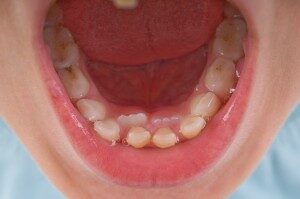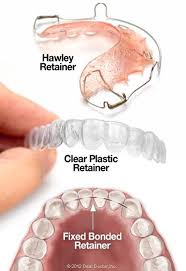August 26th, 2019
Two-phase orthodontic treatment generally means that part of the orthodontic treatment is completed while the patient still has some baby teeth. This part of the treatment is referred to as Phase I and is usually completed sometime between ages 7-10. After the eruption of the remaining adult teeth, the second phase of orthodontic treatment involving full upper and lower braces is completed. This part of the treatment is referred to as Phase II. The idea behind this type of treatment is that some of the more severe orthodontic problems can be treated more effectively by treating them in two stages.

Some examples of problems that can be treated effectively by doing two-phase orthodontic treatment are:
- Creating spacing for severely crowded teeth or repositioning teeth that are developing incorrectly
- Creating facial balance through influencing jaw growth
- Reducing the risk of fracture or uneven wear to protruding teeth or teeth in crossbite
- Preserving space for teeth that have not erupted
- Correcting harmful habits like thumb sucking
- Preventing damage to gum tissue around teeth that are erupting outside of a normal position
The type of appliances that are used in Phase I while patients still have baby teeth varies a lot. It can be as simple as a special retainer to correct one tooth that is really crooked or as complicated as partial upper and lower braces with a palatal expander. If a Phase I treatment has already been completed, Phase II is generally more straightforward involving traditional braces or Invisalign as most of the more severe orthodontic problems have already been corrected in Phase I treatment. Minor problems like mild spacing or crowding, mild overbites, and mild to moderate misalignment can generally be treated just as effectively with a single phase treatment at around age 11-13 depending on the age of eruption of the adult teeth.
July 29th, 2019
It is no exaggeration to say that braces can provide a life-changing result to someone with an unattractive smile – not to mention reduce the risk of tooth decay, gum disease, and fractured teeth. That is one of the reasons I love being an orthodontist. My profession does not deal with life and death – only the quality of life.

However, the benefits of orthodontic treatment are definitely more than just a beautiful smile. Orthodontics is devoted to bringing the teeth, lips, and jaws into a proper, healthy relationship. Straight teeth are much easier to keep clean so having well-aligned teeth can significantly reduce the risk of tooth decay and gum disease. Also, straight teeth are less likely to fracture and they wear more evenly. Healthy, straight teeth will last longer and work better than crooked, ugly teeth. These are some of the scientifically proven benefits of orthodontic treatment.
It has also been proven that an attractive smile inspires confidence in social situations. In a job interview, if you have two equally qualified candidates and one has a beautiful smile and the other does not, the candidate with an attractive smile is more likely to get the job. A healthy, beautiful smile is one of the best investments that parents can make for themselves or their children to open more doors of opportunity and enhance self-confidence for the future. Check out our website to see some of the dramatic changes that can happen with orthodontic treatment.
June 28th, 2019
The simple answer is yes. There are two main reasons why. First, your gums have little elastic fibers in them that attach to the teeth. There is actually a protein in your gums called elastin. The elastic fibers in your gums act like little rubber bands. When you straighten a crooked tooth, the elastic fibers get stretched out and want to recoil to their original positions. These fibers “remember” where the teeth were before treatment began and are the main cause of teeth getting crooked again after orthodontic treatment. By the way, a common misconception is that wisdom teeth are what cause your orthodontic treatment to relapse. This is actually not true - patients who were born without wisdom teeth have the same amount of orthodontic relapse.
Second, teeth naturally tend to move and adjust as you age – regardless of whether you have had orthodontic treatment or not – unless you are wearing retainers.
If you stopped wearing your retainer and your teeth have shifted, all is not lost. Straightening teeth the second time around tends to be easier and faster. A lot of the work was already done the first time around. Invisalign is a great option for those who have had previous treatment with braces but have had some orthodontic relapse. Bonded fixed retainers are a nice option for holding teeth in position for the long term. Check out our website to learn more about retainers.

Remember, it’s easy to slip your retainers in at night before you go to bed to keep your smile straight and beautiful. If you make retainers part of your nighttime routine, you can enjoy beautiful, straight teeth for the rest of your life. If you have had some relapse, please give us a call to get your smile back on track. You’ll be happy you did!
May 15th, 2019
The process by which teeth move is complicated, and many books have been written on the subject. However, there are a few general principles that will help you understand what is happening or will happen in your mouth. Both braces and Invisalign apply a very small, gentle push against crooked teeth which “wakes up” the cells in your jaw bones to make the roots around your crooked teeth start to straighten out.
There are two very important cells in your body that are mostly responsible for remodeling bone – an osteoclast and an osteoblast. The osteoclast is like a pac-man cell that eats bone. The osteoblast does the opposite – it builds bone. Together they work as a team to remodel the bone around the roots of your teeth. This is how an orthodontist changes your teeth from being crooked teeth to straight teeth.

By the way, teeth don’t know what is pushing against them. The “pushing” can be done by braces, Invisalign®, chewing on a pen, sucking on your thumb, or biting your nails. Things like braces and Invisalign® tend to push the teeth in the direction we want them to go (straight) while things like thumb sucking or constantly chewing on a pen tend to make teeth more crooked.
Now that you know more about how teeth move, you can focus on doing those things that will make your teeth straight and beautiful and avoid doing the things that will make them crooked.
Tags: straight teeth, orthodontist, braces, Invisalign, biting your nails, osteoclast, osteoblast, crooked teeth
Posted in Straight teeth, Braces, Invisalign, Crowding | No Comments











 Website Powered by Sesame 24-7™
Website Powered by Sesame 24-7™